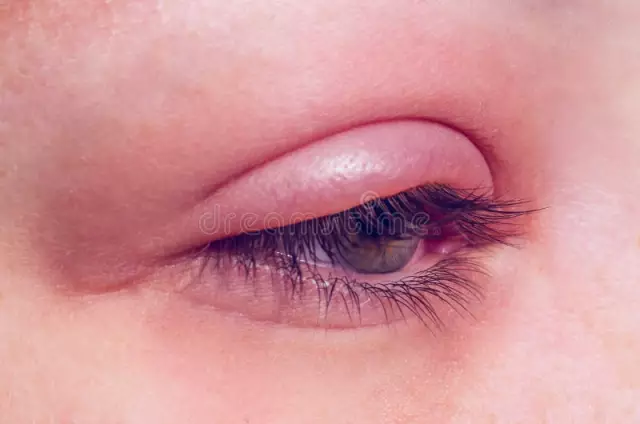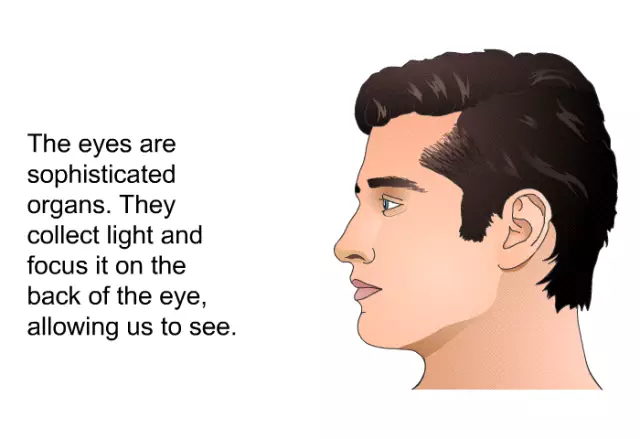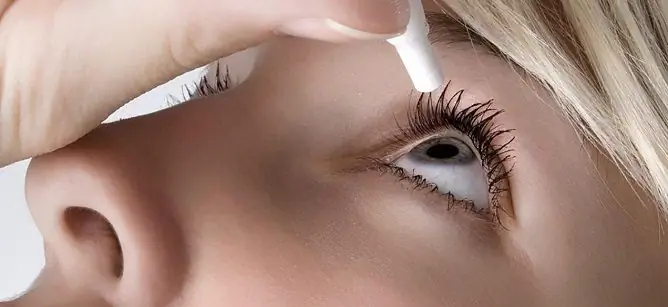- Author Rachel Wainwright [email protected].
- Public 2023-12-15 07:39.
- Last modified 2025-11-02 20:14.
Pilocarpine hydrochloride
Pilocarpine hydrochloride: instructions for use and reviews
- 1. Release form and composition
- 2. Pharmacological properties
- 3. Indications for use
- 4. Contraindications
- 5. Method of application and dosage
- 6. Side effects
- 7. Overdose
- 8. Special instructions
- 9. Application during pregnancy and lactation
- 10. Use in childhood
- 11. Drug interactions
- 12. Analogs
- 13. Terms and conditions of storage
- 14. Terms of dispensing from pharmacies
- 15. Reviews
- 16. Price in pharmacies
Latin name: Pilocarpine hydrochloride
ATX code: S01EB01
Active ingredient: pilocarpine (pilocarpine)
Manufacturer: RUE Belmedpreparaty (Republic of Belarus)
Description and photo updated: 2018-26-11

Pilocarpine hydrochloride is an ophthalmic agent of miotic and antiglaucoma action; m-cholinomimetic.
Release form and composition
The drug is produced in the form of eye drops: a colorless transparent solution (1 ml in a dropper tube, 10 dropper tubes in a cardboard box and instructions for the use of Pilocarpine hydrochloride).
1 ml of solution (1 tube-dropper) contains:
- active substance: pilocarpine hydrochloride - 10 mg;
- additional components: boric acid, water for injection.
Pharmacological properties
Pharmacodynamics
Pilocarpine hydrochloride is an m-cholinostimulating agent, a methylimidazole derivative, with miotic and antiglaucoma properties. The substance leads to miosis - a contraction of the circular muscle, and to accommodation spasm - a contraction of the ciliary (ciliary) muscle. Under the influence of the agent, the angle of the anterior chamber of the eye increases as a result of the retraction of the root part of the iris, the permeability of the trabecular apparatus increases (the trabeculum is stretched and opens the blocked zones of the Schlemm's canal), the outflow of aqueous humor from the anterior chamber of the eye improves, which helps to lower intraocular pressure.
Against the background of primary open-angle glaucoma after instillation of the solution, intraocular pressure decreases by 25-26%. The onset of action of the drug is noted after 30-40 minutes, the maximum effect is achieved after 1.5-2 hours and lasts for 4-8 hours.
Pharmacokinetics
The agent penetrates well into the cornea, is practically not absorbed in the conjunctival sac and does not demonstrate a resorptive effect. The time required to reach the maximum concentration of the substance in the intraocular fluid is 30 minutes. The drug is retained in the tissues of the eye, and therefore its half-life is increased and can reach 1.5-2.5 hours. The substance is excreted with the intraocular fluid unchanged. When introduced into the conjunctival sac, it does not enter the systemic circulation.
Indications for use
- acute attack of angle-closure glaucoma;
- chronic open-angle glaucoma;
- secondary glaucoma (atrophy of the optic nerve, acute obstruction of the retinal arteries, thrombosis of the central retinal vein, pigmentary retinal degeneration);
- corneal abscess;
- mydriasis (in order to diagnose the causes of development).
Also, Pilocarpine hydrochloride is indicated for use if it is necessary to constrict the pupil after instillation of mydriatics.
Contraindications
Absolute:
- iridocyclical crises, iridocyclitis, iritis, anterior uveitis and other eye lesions, against which miosis is undesirable;
- conditions after ophthalmic operations;
- anamnestic data about retinal detachment;
- angle-closure glaucoma;
- bronchial asthma during an exacerbation;
- pregnancy and lactation;
- children and adolescents up to 18 years old;
- hypersensitivity to the components of the drug.
Relative (use pilocarpine hydrochloride eye drops with extreme caution):
- high degree of myopia in young patients;
- damage to the conjunctiva and cornea;
- arterial hypertension, heart disease;
- bronchial asthma;
- peptic ulcer and 12 duodenal ulcer;
- difficulty urinating;
- Parkinson's disease.
Pilocarpine hydrochloride, instructions for use: method and dosage
Pilocarpine hydrochloride is intended for drip injection into the conjunctival sac.
Recommended dosage regimen:
- primary glaucoma: instill 1-2 drops into each eye 2-4 times a day; the duration of therapy and the daily dose are set by the attending physician individually, taking into account the level of intraocular pressure; if necessary, combined use with β-blockers is allowed;
- acute attack of angle-closure glaucoma: 1 drop is administered for 1 hour every 15 minutes, 2-3 hours - every 30 minutes, 4-6 hours - every 60 minutes, then 3-6 times a day until the attack stops.
Before using the product for the first time, remove the protective cap from the dropper tube and cut off, without damaging the threaded part, the membrane of the body neck. Wash your hands before instillation. Throwing your head back, you need to pull the lower eyelid down and look up. Holding the dropper tube with the neck down and gently pressing on its body, you should inject 1 drop into the space between the eyelid and the eyeball, and then, closing the eye, blot it with a dry cotton swab.
In order to increase the effectiveness of Pilocarpine hydrochloride, reduce its absorption and reduce the risk of systemic side effects, without opening the eyes, it is recommended to squeeze the ophthalmic canal for 1-2 minutes by pressing with a finger in the area of the inner corner of the eye. Do not touch the tip of the dropper tube to the eyelids, eyelashes, or any other surface. After the procedure, you must tightly close the tube and wash your hands.
Side effects
- local effects: short-term pain in the eye, redness, increased lacrimation, itching in the eye area, miosis, conjunctival hyperemia, spasm of accommodation caused by persistent miosis (at night), pain in the paraorbital areas and temples, decreased visual acuity, photophobia, edema and corneal erosion, superficial keratitis, ciliary muscle spasm, eyelid dermatitis, and allergic conjunctivitis; rarely - retinal detachment;
- systemic effects (extremely rare): vomiting, diarrhea, nausea, hypersalivation, dizziness, headache, vascular disorders, arterial hypotension, bradycardia, increased blood pressure (BP), excessive sweating, rhinorrhea, bronchospasm, pulmonary edema.
Long-term therapy can provoke the development of disorders such as follicular conjunctivitis, keratopathy, contact dermatitis of the eyelids, cataracts, changes in conjunctival tissue, reversible lens opacity.
Overdose
Symptoms of an overdose of the drug may include: increased sweating, increased intestinal motility, nausea, decreased blood pressure, heart rhythm disturbances (including bradycardia), as well as other manifestations of the systemic action of pilocarpine.
In this condition, it is recommended to reduce the frequency of instillations or to discontinue pilocarpine hydrochloride.
special instructions
During therapy, it is necessary to carry out regular monitoring of intraocular pressure.
Since the use of eye drops of Pilocarpine hydrochloride in rare cases can lead to retinal detachment, a fundus examination is required before starting the course, especially if there is a history of retinal pathological changes.
In patients with initial cataract, the myotic effect can cause temporary visual impairment (a feeling of myopia), which does not require discontinuation of Pilocarpine hydrochloride.
At the very beginning of the course of therapy in young patients, the risk of accommodation spasm increases, due to which a decrease in visual acuity is possible.
An intensely pigmented iris is more resistant to the influence of miotics, as a result of which, to achieve the desired effect, the concentration of the solution or the frequency of its administrations is increased, which increases the threat of an overdose.
An increase in the level of the active substance Pilocarpine hydrochloride and an increase in the frequency of instillations (6 or more times) is not advisable, since this does not enhance the hypotensive effect of the drug and can provoke systemic side effects. It is recommended to replace pilocarpine with other non-myotic drugs for 1-3 months throughout the year.
Influence on the ability to drive vehicles and complex mechanisms
Miosis can lead to impaired dark adaptation. Caution should be exercised after the drops are administered to patients driving vehicles or performing other potentially hazardous work in the dark or in poor lighting conditions.
Application during pregnancy and lactation
In animal studies, it was found that pilocarpine has a teratogenic effect. Use of Pilocarpine hydrochloride is contraindicated during pregnancy. If necessary, use of the drug during lactation should stop breastfeeding.
Pediatric use
There are no data confirming the efficacy and safety of pilocarpine hydrochloride in children and adolescents. It is not recommended to use an ophthalmic agent in patients under 18 years of age.
Drug interactions
- m-anticholinergics (including atropine): antagonism towards these drugs is manifested;
- adrenomimetics: there is an antagonism of the action (on the diameter of the pupil);
- phenylephrine and timolol: the risk of a decrease in intraocular pressure is aggravated (the production of intraocular fluid decreases);
- carbonic anhydrase inhibitors, beta-blockers, sympathomimetics: a combination with these agents is allowed;
- clozapine, chlorprothixene, phenothiazine derivatives, tricyclic antidepressants: the m-cholinomimetic activity of pilocarpine hydrochloride is weakened;
- cholinesterase inhibitors: m-cholinomimetic activity increases;
- halothane: The risk of bradycardia and a decrease in blood pressure increases during general anesthesia with this drug.
Analogs
Analogs of Pilocarpine hydrochloride are: Pilocarpine, Pilocarpine-Ferein, Pilocarpine-DIA, Pilocarpine-long, Pilocarpine with methylcellulose, Oftan Pilocarpine, Pilocarpine bufus.
Terms and conditions of storage
Store in a place protected from light, out of reach of children, at a temperature of 8-15 ° C.
The shelf life is 3 years. After opening the dropper tube, the drug can be used for 7 days if stored at a temperature of 8-15 ° C.
Terms of dispensing from pharmacies
Dispensed by prescription.
Reviews of Pilocarpine hydrochloride
Reviews of Pilocarpine hydrochloride are mostly positive. Patients note that the agent helps to reduce intraocular pressure, reduce the frequency of development of pain in the eyes and weaken their intensity. According to reviews, the drops help to eliminate clouding of the eyes, rainbow circles in front of the eyes and other situational visual defects. By gently acting on the mucous membrane, the drug also relieves swelling of the eyes. The highest efficacy of the agent in the treatment of glaucoma affected parts of the eye was noted when it was used as part of complex therapy.
To use Pilocarpine hydrochloride, according to patients, should only be prescribed by a doctor, following all his recommendations.
Price for Pilocarpine hydrochloride in pharmacies
Currently, the exact price of Pilocarpine hydrochloride is unknown, since the drug is not sold in pharmacies. The price of an analogue of Pilocarpine eye drops 1% can be 20-40 rubles per package containing 5 ml.

Maria Kulkes Medical journalist About the author
Education: First Moscow State Medical University named after I. M. Sechenov, specialty "General Medicine".
Information about the drug is generalized, provided for informational purposes only and does not replace the official instructions. Self-medication is hazardous to health!






